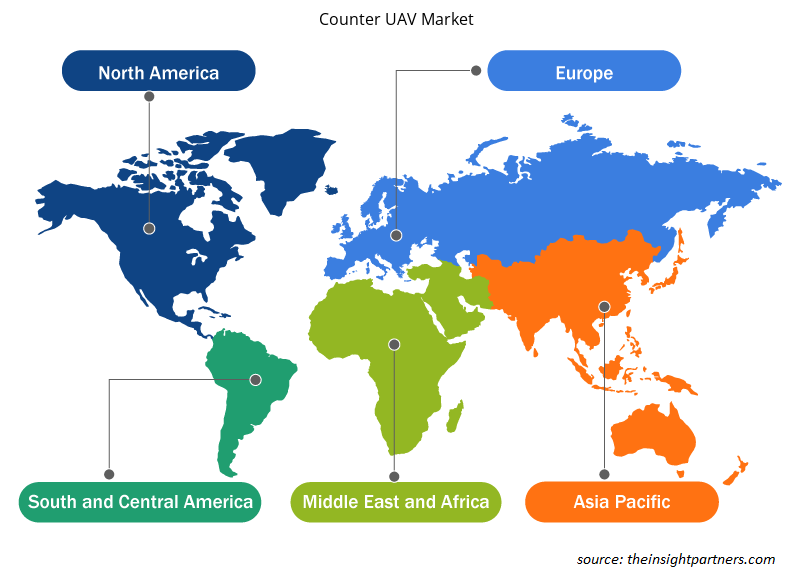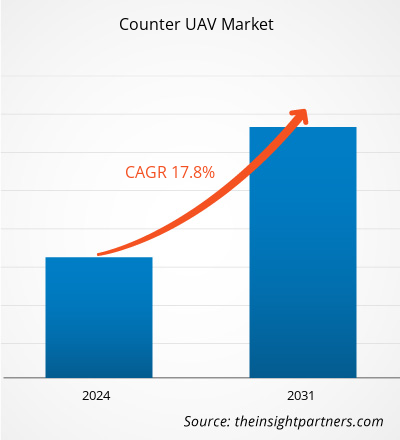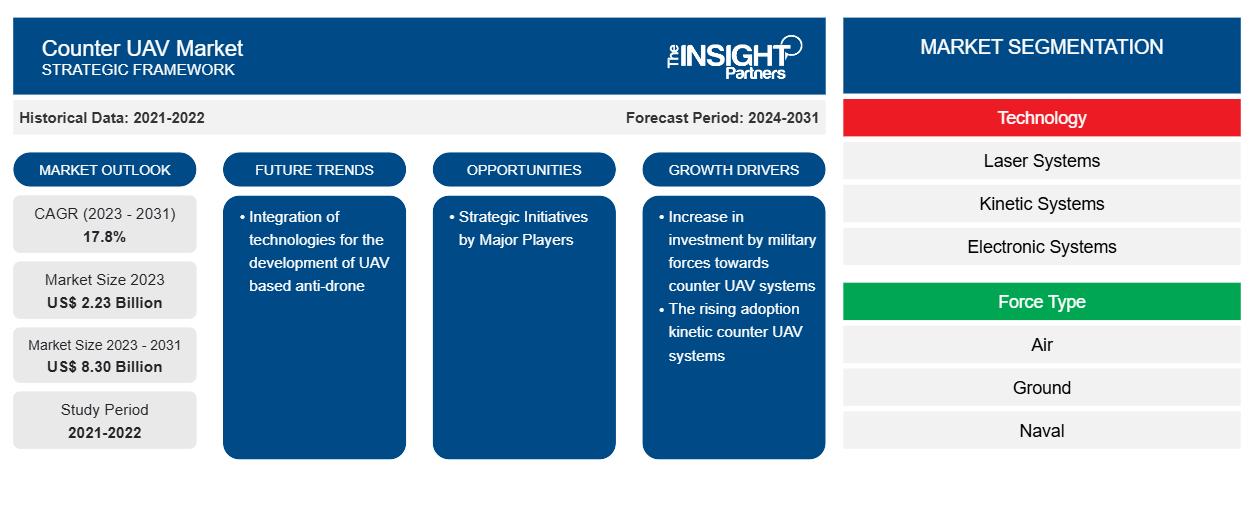Le marché des drones anti-drones devrait atteindre 8,30 milliards USD d'ici 2031, contre 2,23 milliards USD en 2023. Le marché devrait enregistrer un TCAC de 17,8 % au cours de la période 2023-2031. L'intégration des technologies pour le développement de systèmes anti-drones basés sur des drones devrait rester une tendance clé du marché.
Analyse du marché des contre-drones
Lockheed Martin Corporation, Thales Group, Northrop Grumman Corporation, Leonardo SpA et Rafael Advanced Defense Systems Ltd comptent parmi les principaux acteurs du marché opérant sur le marché mondial de la lutte anti-drone. Les principaux acteurs sont classés en fonction de facteurs tels que le chiffre d'affaires global, le portefeuille actuel de produits anti-drones, la portée géographique, les initiatives du marché, les investissements dans les mises à niveau technologiques, les partenariats et d'autres activités liées au marché.
Aperçu du marché des contre-drones
Les principaux acteurs de l'écosystème mondial du marché de la lutte anti-drone comprennent, entre autres, les fabricants de composants, les intégrateurs de systèmes et les utilisateurs finaux. Un radar de système de lutte anti-drone est composé de divers composants tels que des capteurs et des systèmes GPS qui sont achetés par les fabricants de systèmes auprès d'une vaste base de fabricants de composants. Ces fabricants de composants fournissent les pièces de base aux acteurs du marché mondial de la lutte anti-drone. Les intégrateurs de systèmes sont les entreprises qui se consacrent à la fabrication des systèmes anti-drone après l'intégration de chaque composant. Parmi les principaux acteurs opérant sur le marché, on trouve Raytheon Technologies Corporation, Rafael Advanced Defense Systems Ltd., Thales Group, Lockheed Martin Corporation et Israel Aerospace Industries Ltd., entre autres. L'utilisateur final du marché mondial de la lutte anti-drone comprend les forces aériennes, terrestres et navales qui sont engagées dans la défense et la sécurité intérieure des pays. Les solutions de lutte anti-drone ont également connu une augmentation de leur adoption par les forces de sécurité intérieure pour les événements et concerts privés mondiaux. Ainsi, l’augmentation des dépenses militaires des pays développés et en développement et leurs investissements croissants pour assurer la sécurité des frontières terrestres et côtières contre les drones hostiles favorisent également l’adoption massive de solutions anti-UAV à travers le monde.
Personnalisez ce rapport en fonction de vos besoins
Vous bénéficierez d'une personnalisation gratuite de n'importe quel rapport, y compris de certaines parties de ce rapport, d'une analyse au niveau des pays, d'un pack de données Excel, ainsi que de superbes offres et réductions pour les start-ups et les universités.
-
Obtenez les principales tendances clés du marché de ce rapport.Cet échantillon GRATUIT comprendra une analyse de données, allant des tendances du marché aux estimations et prévisions.
Facteurs moteurs et opportunités du marché des dronesUAV Market Drivers and Opportunities
Adoption croissante des systèmes de drones à compteur cinétiqueUAV Systems
Les systèmes anti-drones cinétiques sont utilisés par les organismes militaires du monde entier pour abattre complètement un drone. Ils utilisent des lignes ou des filets anti-drones qui sont généralement lancés à l'aide d'air comprimé ou d'un autre drone. Ces dispositifs permettent de capturer le drone, de le neutraliser ou de le détruire. Parfois, des drones inconnus sont envoyés à l'intérieur des frontières militaires pour étudier la zone ou pour surveiller de près les allées et venues des adversaires. Dans de tels cas, la destruction complète du drone garantit une sécurité accrue aux forces militaires.UAV systems are used by military bodies across the globe to completely take down a drone. It utilizes anti drone weight lines or nets which is generally launched with the help of compressed air, or another UAV. These devices help to capture the drone, neutralize it or destroy the same. Some time, unknown drones are sent within military boundaries to study the area or to keep a close eye to the opponents where-abouts. In such cases, destroying the complete drone ensures enhanced safety to the military forces.
Certaines des principales entreprises proposent des systèmes anti-drones cinétiques, notamment KWESST Micro Systems Inc. et Zen Technologies Limited. KWESST Micro Systems Inc. propose des micro-drones pour l'interdiction cinétique des petits drones, y compris les essaims, qui peuvent être lancés par des soldats. Il s'agit d'un drone entièrement automatique qui aide à identifier les drones, à les suivre, à les chasser et à les neutraliser grâce à la technologie cinétique. Ces systèmes couvrent également une portée de 4 km. En octobre 2021, la société a annoncé le développement d'un nouveau système anti-drones en réponse à la menace croissante des munitions rôdeuses.UAV systems include KWESST Micro Systems Inc. and Zen Technologies Limited amongst others. KWESST Micro Systems Inc., offers micro-drone for kinetic interdiction of small drones, including swarms, that can be launched by soldiers. It is a fully automatic drone which helps in the dentification of drones, track, hunt and neutralize them with kinetic technology. These systems also cover a range of 4km. The company in October 2021, announced the development of new counter UAV system in response to the rapidly increasing threat of loitering munitions.
Initiatives stratégiques des principaux acteurs
La multiplication des attaques terroristes et l’instabilité politique dans les pays développés et en développement poussent les forces de défense et de sécurité intérieure à accroître leurs achats de solutions avancées telles que les systèmes radar, les systèmes de communication et les technologies anti-drones, entre autres. Par exemple, le ministère de la Défense des États-Unis, l’Union européenne et d’autres autorités comme le ministère indien de la Défense ont augmenté leurs dépenses consacrées à l’achat de solutions anti-drones au fil des ans. Cela conduit les fabricants de drones anti-drones à adopter des stratégies de croissance organique et inorganique, telles que des investissements élevés, des offres de produits et une expansion mondiale, créant ainsi de nouvelles opportunités de croissance pour le marché mondial des drones anti-drones.amongst others. For instance, department of defense of US, European Union and other authorities like Indian defense ministry has increased their spending on procurement of anti-drones over the years. This is leading the counter UAV manufacturers to adopt organic and inorganic growth strategies, such as high investments, product offerings, and global expansion, further creating growth opportunities for the global counter UAV market.
Analyse de segmentation du rapport sur le marché des drones de contre-attaque
Les segments clés qui ont contribué à l’élaboration de l’analyse du marché des contre-UAV sont la technologie, le type de force, le type de produit, la configuration et les utilisateurs finaux.
- Sur la base de la technologie, le marché des contre-drones est segmenté en systèmes laser, systèmes cinétiques et systèmes électroniques. Le segment des systèmes électroniques détenait une part de marché plus importante en 2023.
- En fonction du type de force, le marché des drones anti-aériens est segmenté en aérien, terrestre et naval. Le segment terrestre détenait une part de marché plus importante en 2023.
- En fonction du type de produit, le marché des drones anti-aériens est segmenté en drones terrestres et drones portatifs. Le segment terrestre détenait une part de marché plus importante en 2023.
- En fonction de la configuration, le marché des drones de contre-attaque est divisé en deux catégories : les drones portables et les drones stationnaires. Le segment stationnaire détenait une part de marché plus importante en 2023.
- En fonction de la configuration, le marché des drones anti-aériens est classé en deux catégories : la défense et la sécurité intérieure. Le segment de la défense détenait une part de marché plus importante en 2023.
Analyse des parts de marché des contre-drones par zone géographique
La portée géographique du rapport sur le marché des drones de comptoir est principalement divisée en quatre régions : l’Amérique du Nord, l’Europe, l’Asie-Pacifique et le reste du monde.
Français L'Amérique du Nord a dominé le marché en 2023, suivie de l'Europe et de la région Asie-Pacifique. En outre, l'Asie-Pacifique devrait également connaître le TCAC le plus élevé dans les années à venir. Les États-Unis représentent une part importante du marché nord-américain de la lutte contre les drones. Les systèmes anti-UAV, selon le ministère américain de la Défense (DOD), aident l'armée américaine à détecter et à neutraliser les drones hostiles ou attaquants. En raison de leur taille, de leur matériau de construction et de leur altitude de vol, de nombreux drones plus petits sont indétectables par les systèmes de défense aérienne classiques. En conséquence, le ministère américain de la Défense (DOD) prévoit de dépenser au moins 636 millions de dollars américains pour la recherche et le développement de contre-UAS (C-UAS) au cours de l'exercice 2022, ainsi qu'au moins 75 millions de dollars américains pour l'approvisionnement en C-UAS, soit une augmentation de 134 millions de dollars américains par rapport à l'exercice 2021. Alors que le DoD américain continue de développer, d'acheter et de déployer ces technologies, contribuant à la croissance du marché.
Aperçu régional du marché des drones de contre-attaque
Les tendances et facteurs régionaux influençant le marché des contre-drones tout au long de la période de prévision ont été expliqués en détail par les analystes d'Insight Partners. Cette section traite également des segments et de la géographie du marché des contre-drones en Amérique du Nord, en Europe, en Asie-Pacifique, au Moyen-Orient et en Afrique, ainsi qu'en Amérique du Sud et en Amérique centrale.

- Obtenez les données régionales spécifiques au marché des drones anti-drones
Portée du rapport sur le marché des contre-drones
| Attribut de rapport | Détails |
|---|---|
| Taille du marché en 2023 | 2,23 milliards de dollars américains |
| Taille du marché d'ici 2031 | 8,30 milliards de dollars américains |
| Taux de croissance annuel composé mondial (2023-2031) | 17,8% |
| Données historiques | 2021-2022 |
| Période de prévision | 2024-2031 |
| Segments couverts |
Par technologie
|
| Régions et pays couverts |
Amérique du Nord
|
| Leaders du marché et profils d'entreprises clés |
|
Densité des acteurs du marché : comprendre son impact sur la dynamique des entreprises
Le marché des drones de contre-attaque connaît une croissance rapide, tirée par la demande croissante des utilisateurs finaux en raison de facteurs tels que l'évolution des préférences des consommateurs, les avancées technologiques et une plus grande sensibilisation aux avantages du produit. À mesure que la demande augmente, les entreprises élargissent leurs offres, innovent pour répondre aux besoins des consommateurs et capitalisent sur les tendances émergentes, ce qui alimente davantage la croissance du marché.
La densité des acteurs du marché fait référence à la répartition des entreprises ou des sociétés opérant sur un marché ou un secteur particulier. Elle indique le nombre de concurrents (acteurs du marché) présents sur un marché donné par rapport à sa taille ou à sa valeur marchande totale.
Les principales entreprises opérant sur le marché des drones anti-drones sont :
- Système de surveillance Blighter Ltd
- Dédrone
- Bouclier de drone
- Industries aérospatiales israéliennes Ltd.
- Spa Leonardo
Avis de non-responsabilité : les sociétés répertoriées ci-dessus ne sont pas classées dans un ordre particulier.

- Obtenez un aperçu des principaux acteurs du marché des contre-drones
Actualités et développements récents du marché des drones
Le marché des contre-drones est évalué en collectant des données qualitatives et quantitatives après des recherches primaires et secondaires, qui comprennent d'importantes publications d'entreprise, des données d'association et des bases de données. Quelques-uns des développements sur le marché des contre-drones sont énumérés ci-dessous :
- Elbit Systems dévoile une nouvelle et unique capacité de guerre électronique (EW) au salon aéronautique de Paris dans le cadre de sa suite EW unifiée. La nouvelle capacité est fournie par les récepteurs d'alerte radar numériques (RWR), une partie de la suite EW d'autoprotection aéroportée éprouvée d'Elbit, et permet la détection et l'identification des drones ainsi que la localisation des balises de localisation personnelles (PLB) des forces terrestres et des pilotes. (Source : Elbit Systems Ltd, communiqué de presse, juin 2023)
- Elbit Systems Ltd (NASDAQ : ESLT et TASE : ESLT) Elbit Systems a annoncé aujourd'hui avoir remporté un contrat d'une valeur d'environ 55 millions de dollars pour la fourniture de systèmes aériens sans pilote multicouches ReDrone (C-UAS) aux Pays-Bas. Le contrat sera exécuté sur une période de quatre ans. (Source : Elbit Systems Ltd, communiqué de presse, août 2023)
Rapport sur la couverture et les livrables du marché des drones anti-drones
Le rapport « Taille et prévisions du marché des contre-UAV (2021-2031) » fournit une analyse détaillée du marché couvrant les domaines ci-dessous :
- Taille et prévisions du marché des drones de comptoir aux niveaux mondial, régional et national pour tous les segments de marché clés couverts par le champ d'application
- Contrer les tendances du marché des drones ainsi que la dynamique du marché, comme les moteurs, les contraintes et les opportunités clés
- Analyse détaillée des cinq forces du porteur
- Analyse du marché des drones de contre-mesure couvrant les principales tendances du marché, le cadre mondial et régional, les principaux acteurs, les réglementations et les développements récents du marché
- Analyse du paysage industriel et de la concurrence couvrant la concentration du marché, l'analyse de la carte thermique, les principaux acteurs et les développements récents pour le marché des drones anti-drones
- Profils d'entreprise détaillés
- Analyse historique (2 ans), année de base, prévision (7 ans) avec TCAC
- Analyse PEST et SWOT
- Taille du marché Valeur / Volume - Mondial, Régional, Pays
- Industrie et paysage concurrentiel
- Ensemble de données Excel
Rapports récents
Témoignages
Raison d'acheter
- Prise de décision éclairée
- Compréhension de la dynamique du marché
- Analyse concurrentielle
- Connaissances clients
- Prévisions de marché
- Atténuation des risques
- Planification stratégique
- Justification des investissements
- Identification des marchés émergents
- Amélioration des stratégies marketing
- Amélioration de l'efficacité opérationnelle
- Alignement sur les tendances réglementaires























 Obtenez un échantillon gratuit pour - Marché des contre-drones
Obtenez un échantillon gratuit pour - Marché des contre-drones